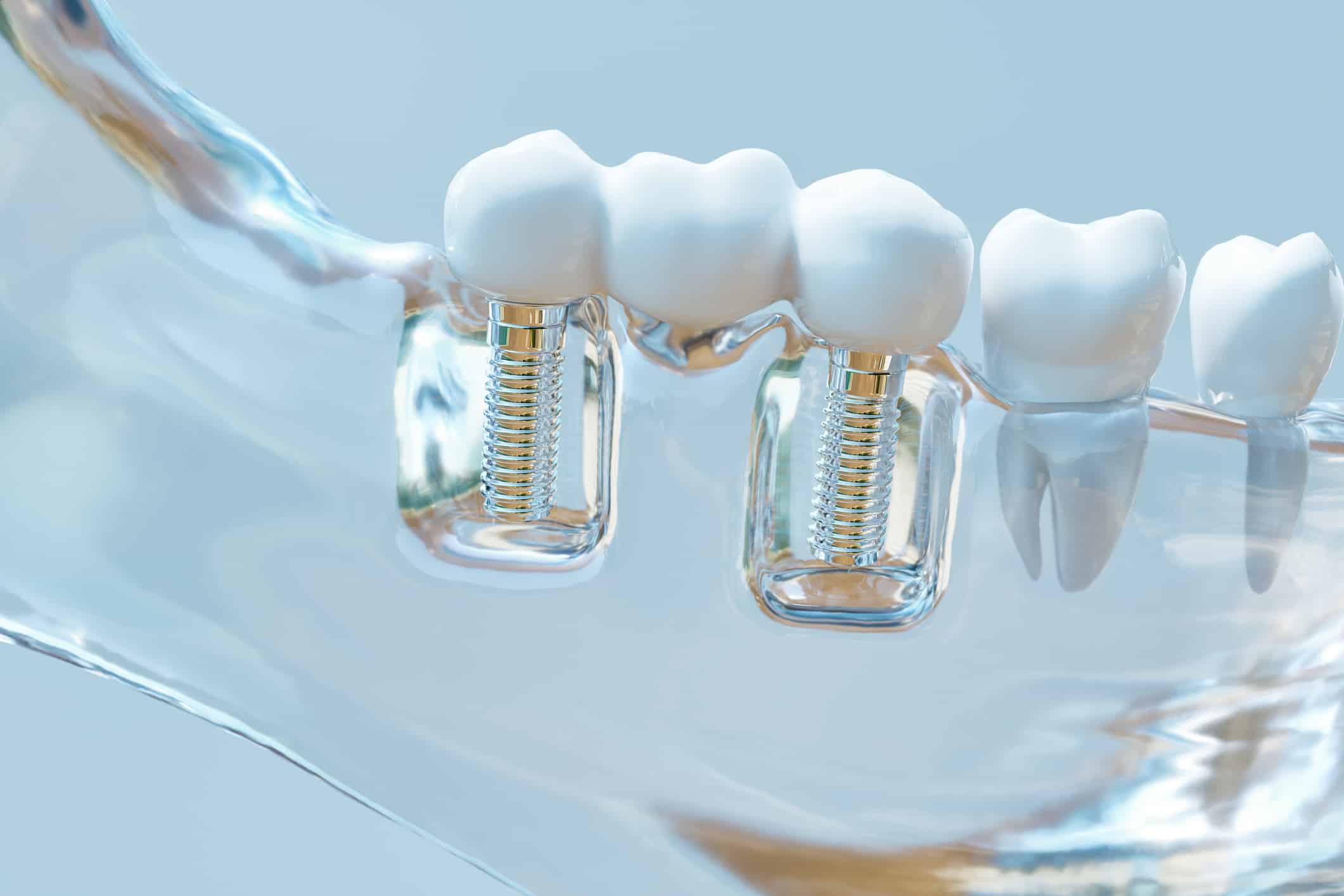A prosthesis is a synthetic replacement of part of a patient’s face such as the eye, ear, nose, hard palate, or teeth, that has been removed by an ablative surgery. The prosthesis is made from a special material and is designed and created specifically for the patient by a maxillofacial prosthodontist.
A prosthesis can supplement other reconstructive methods such as the restoration of teeth after reconstruction of the upper or lower jaw(s). Alternatively, in cases such as hard palate and maxilla defects, a prosthesis can replace the need for major reconstruction. This is also true for the use of a prosthesis to replace a missing ear or nose.
Surgeons do have the ability to reconstruct these anatomic structures with a patient’s own tissue, but usually not as accurately as can be achieved with a prosthesis. In the case of restoring a patient’s eye, there is no reconstructive technique currently available that is capable of restoring a globe, so a prosthesis is necessary.
Advantages & Disadvantages
The advantages of a prosthesis are that it can help to eliminate the need for a patient to undergo additional major surgery. Maxillofacial prosthetic rehabilitation may lead to the best cosmetic outcome for certain structures such as the ear, nose, or eye. Another advantage of a prosthesis is that, since the device can be removed, it allows the surgeon to closely monitor the underlying area for any signs of tumor recurrence. However, with the advent of newer and better imaging techniques (including scans such as CT, MRI, and PET) that allow for better monitoring, this advantage is considered less important.
There are disadvantages to the use of a prosthesis. For one, patients have to remove the device on a daily basis to keep it clean. It can also take some time for doctors (referred to as prosthodontists) to adjust the prosthesis to achieve a good fit that minimizes patient discomfort. Patients undergoing radiation treatment face additional challenges with prosthetic management that may not be resolved until after radiation and healing are completed. Additionally, some patients have difficulty accepting prostheses, which may be poorly tolerated due to their artificial nature. Prosthetics can also be expensive and may not be covered by certain insurance carriers.
Types of Prostheses
A prosthesis can be either tissue-borne or implant-borne.
Tissue-borne Prosthesis
A tissue-borne prosthesis is held in place either by clasping to nearby normal tissue, such as adjacent teeth, or by sticking to the skin with the use of a variety of adhesives.
Implant-borne Prosthesis
An implant-borne prosthesis requires surgery to insert titanium implants into the bone under the area where the prosthesis will be placed. After a period of three to four months, the titanium implants become solidly healed (integrated) to the bone. This process is called osseointegration. Once the implants have been fully integrated, the prosthesis can be secured to the implants. An implant-borne prosthesis eliminates the need for any glues or adhesives, thereby improving overall functional recovery and maintenance and offers the highest level of stability and retention.
In the case of dental prostheses, an implant-borne prosthesis can be either removable or fixed. A fixed dental prosthesis is retained by screws that are placed through the prosthesis into the titanium implants, and can be removed by a prosthodontist or dentist for maintenance or repair.
Prosthetic Devices
The specific details of prosthetic rehabilitation will depend on the area in which the prosthetic device is being used.
Palate & Maxilla Prosthesis
For tumors of the sinuses, maxilla and/or hard palate, patients will likely undergo a maxillectomy, which involves removing the maxilla, or the upper jawbone. Following this surgery, rehabilitation will be required. This can be accomplished by reconstruction, using either hard or soft tissue replacement by borrowing from another part of the body. Alternatively, a prosthetic obturator can achieve closure of the opening in the palate by placing a removable prosthesis to close the defect.
If an obturator is determined to be the best option, the patient will be evaluated by a prosthodontist prior to surgery to have an impression made of their palate. After tumor removal, a temporary (surgical) obturator will be secured to the remaining hard palate or remaining teeth in the operating room. After this, an interim obturator will be specially designed for the patient as the wound contracts and changes over time. This device can be easily modified as the defect changes so that the prosthesis maintains a seal of the oral cavity and prevents communication with the maxillary sinus and nasal cavities above. A definitive prosthesis will be created once the maxillary defect has completely healed, and no further changes are anticipated. A maxillary prosthesis is typically a tissue-borne prosthesis. However, in the absence of healthy upper teeth, implants can be placed in the remaining bone to anchor the obturator. The prosthesis must be removed and cleaned frequently.
Auricular Prosthesis
If surgery requires the removal of a patient’s ear, an artificial ear can be created to look just like a natural ear. This is best done by way of an implant-borne prosthesis, in which implants are placed into the bone surrounding the ear canal (temporal bone). Once the implants are integrated, the prosthesis can be attached. It can be removed as needed to keep it clean. Medical-grade adhesive can also be used instead of implants to keep the prosthesis in place, but this method is less preferable for most patients.
Nasal Prosthesis
For cases in which all or part of the nose was removed in order to treat a cancer, an artificial nose can be created to look just like the patient’s original nose. Adhesives are generally used to keep the prosthesis in place, but implants can be applied to the forehead at the top of the nasal opening (frontal bone) in certain cases. A nasal prosthesis can also be held in place by eye glasses in some patients.
Orbital Prosthesis
If surgery requires the removal of an eye, an orbital prosthesis can be used to restore the appearance of the eye. In this case, a flap or skin graft will typically be used to fill most of the space in the eye socket, and a temporary orbital spacer will be placed to preserve a pocket in which a prosthesis can be placed at a later date. This is usually a tissue-borne prosthesis, but implants can be placed into the facial (frontal) bones to help secure the prosthesis.
Speech & Swallowing Prosthetic Devices
A palatal augmentation prosthesis is a prosthetic device that reshapes the hard palate on the roof of the mouth in order to improve the contact between the tongue and the roof of the mouth in patients treated with a partial or total glossectomy. The removal of part of the tongue makes it difficult for patients to move food products back into the throat. By augmenting the roof of the mouth, the remaining or reconstructed tongue can more easily make contact with the prosthesis, thereby improving speech and swallowing.
A speech aid prosthesis is a removable prosthesis used to restore a defect of the soft palate. A portion of the prosthesis extends into the pharynx in order to separate the oropharynx and nasopharynx during speech and swallowing, thereby completing the palatopharyngeal seal.
A palatal lift prosthesis elevates the soft palate superiorly and helps to restore the functions of the soft palate that may have been lost as a result of tumor removal. Before patients receive a definitive palatal lift prosthesis, they will usually try out a diagnostic palatal lift, to see if it is successful in restoring their function. This is generally done in patients who are not candidates for surgical reconstruction.
Dental Rehabilitation
When the upper jaw (maxilla) or lower jaw (mandible) and the accompanying teeth are removed during the surgical resection of a tumor, the patient may be eligible for dental rehabilitation. This involves the placement of prosthetic teeth to help them eat normally and to improve their quality of life. Prosthetic teeth also improve a patient’s appearance following a major ablative surgery.
Tissue-borne prostheses for dental rehabilitation are difficult to keep in place due to the forces of chewing, the constant motion, and the moist environment. This is particularly true following reconstruction of the oral cavity, which alters the normal anatomy of the mouth and makes it challenging to achieve a stable denture. Therefore, implant-borne prostheses are the preferred method to restore the teeth after resection of the upper or lower jawbones for cancer.
Dental rehabilitation is best accomplished in conjunction with a bone-containing free flap reconstruction, because implants must be placed into healthy bone. For example, after removing part of the mandible along with the teeth, a surgeon might perform a fibula free flap to restore continuity of the lower jawbone. The fibula not only preserves the relationship of the remaining upper and lower teeth but also provides healthy bone that can receive implants for a dental prosthesis. The timing of implant placement and denture placement will depend on the timing of any necessary radiation treatment following tumor removal. A surgeon will likely place implants at the time of fibula reconstruction of the jaw or soon thereafter, which happens before radiation. This approach to implant placement improves the success of the integration into the bone. Radiation treatment damages the bone in the affected area by decreasing healing and limiting the blood supply to the bone. As bone vascularity is required for osseointegration of implants, it is important to place the implants before any radiation treatment takes place, so that the implants can successfully integrate into the bone while the bone still has an intact blood supply.
What is the Process of Fabricating a Facial Prosthesis to Replace an Eye, Nose or Ear?
Designing a custom-made prosthesis usually requires multiple visits to a maxillofacial prosthodontist or anaplastologist (a non-physician healthcare professional who creates custom prosthetics and implants). The first step is to create an impression or digital scan of the area that requires a prosthesis, followed by the building of a plaster or resin model. A sculpture of the prosthesis is generally made out of wax or clay. The sculpture is then refined, and can then be shown to the patient for any additional edits, and then for their approval. A split cast mold is then made of the sculpture, and a silicone-based prosthesis is fabricated. Finally, the prosthesis is painted and characterized to look as natural as possible. This whole process can take several weeks. Future refinements to the prosthesis may be necessary if it no longer fits adequately, or if the patient’s wound changes over time.

Top Questions for Your Doctor
Access our list of the most important questions to ask your physician at your next appointment.













